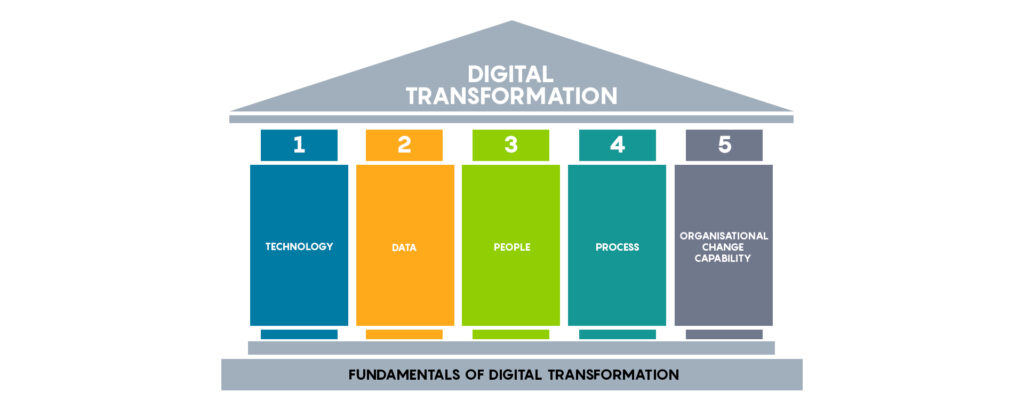You have most likely heard of the term ‘digital transformation’, but interestingly enough, it has very little to do with technology. It has more to do with how well a business can adapt to the rapidly changing and digitising world of economy and commerce.
It Is Not All About Technology
The most widely known and accepted definition of digital transformation is the integration of technology into the various areas of a business, which fundamentally changes how the business functions. Yes, the technological aspect is important but it goes far beyond that.
It is a change in workspace culture as well. For digital transformation to happen effectively, there needs to be a willingness to move away from the status quo, that is to say, from long-standing business models. The technologies that you integrate into the business is not what transforms it – it is how you implement them in parallel to the business operations that matter. The technology is merely a tool, at the heart of digital transformation, is strong work culture and leadership.

Why Is It Necessary?
Think of it as a sink-or-swim kind of situation. The business practices that were in place a century ago, at the dawn of the industrial revolution, cannot be used in today’s context. Though there are certain principles, practices, and theories that we still use, they are used in parallel to modern-day practices. In the same way, today’s practices will, for the most part, change sooner or later.
It becomes a question of survival for a business, especially in today’s rapidly changing economy. The COVID-19 pandemic and the global lockdown that ensued brought the need for these changes into the limelight. The need for business to operate digitally skyrocketed.
With the requirements of employee/customer safety measures at an all-time high, there came a change in the form of the work-from-home business model. The very nature of businesses changed as companies had to operate in such a way that it could still reach its customers while adhering to social distancing and safety norms.
Despite the sudden change, the adoption of digital methodologies has proven quite useful and more efficient for the most part. That said, it is unlikely to go back to how things were and it is because of these reasons that digital transformation is an ever-growing necessity in today’s context.
‘‘
There has never been such a dire need for more advanced digital infrastructure in a day and age where work from is the norm.
Fundamentals You Need To Worry About
The simple fact is digital transformation projects, for the most part, end in failure. Harsh as this may sound, it is true. The average digital transformation process, no matter how well planned, often fails because it lacks one or more of the fundamentals that are needed to make it successful. Success requires you to pull together the fundamentals into a single, unified process. They are technology, data, people, process and organisational change capabilities.
Technology
With technological advancements comes many solutions in the form of the Internet of Things, AI, blockchains and cloud computing. Though they all play an integral part in digital transformation, they are only one part of the equation. The other half is how you can integrate them into existing business processes, which is arguably far more complex than the tools themselves.
Most companies operate on older methodologies which have been in place so long, that changing them or suddenly introducing new technology into the mix could severely disrupt how the business operates. That is why it helps to have a plan for gradual technology integration in place before jumping in. Another thing that can help with that is a skilled IT department.
Data
It goes hand-in-hand with the technology aspect, yet it is one of the most neglected parts of the process. This is not to say that it is completely ignored – companies are very well-aware of the data they have access to and they know it may not be up to standard to achieve what is needed.
The issue lies in the mishandling of data, either because the company lacks the infrastructure to process it or skilled personnel to do it. You need to have a team that can decipher large pools of data in short periods of time, while also being able to differentiate and discard data that is not usable. Streamlining is the aim.
People
Speaking of hiring a team that can handle large amounts of data, you need to ensure that, even after you select and hire the most skilled individuals, you continue to refine and hone their skills. The more training, they receive on a regular basis, the more upskilling happens and the smoother the integration process will go.
Process
There is a need to change the operational process of the business in parallel to the digital transformation. The change that needs to happen comes in the form of rethinking ways in which the new digital approach can help deliver to the customer what they want. The challenge that comes with this move for change is that most businesses and management heads find it difficult to do so while clinging to traditional hierarchical structures. As a result, this aspect has been very neglected and turns the transformation process into a cautious approach. While these incremental steps are valuable, they are not really transformational.
The solution for this perhaps lies in moving away completely from such a mindset, in favour of something more modern. As much as you change the technology to suit the times, you must also change the nature of the business to suit the transformation.
Organisational Change Capability
This aspect has more to do with the managerial and leadership domains of the transformation process. Other than the usual – good communication skills, listening, work ethics and so on – the context here is a skill. Skill in the sense that whoever is leading the charge on the digital transformation of a business, has to be an expert on the subject.
If not, all the time and money invested in it will be pointless as the project will fail or not take hold as effectively. Outsourcing is the best way to find such skilled individuals who can lead the change in the ‘human’ side of things.

Digital Transformation Trends Of 2020
There will be rapid adoption of digital transformation operations across various industries out of sheer need.
Those who have invested in big data governance and analytics will overtake the competition.
An uptake in the use of AI and machine learning in the workplace will go up. At the other end of the spectrum, blockchains will also become a prominent feature for the storage and access of huge pools of data.
More IT services will be outsourced when specialised skills are needed.
Digital partnerships will run rampant between businesses, for example – influencers collaborating with businesses that feature prominently on Instagram for more cross-promotions and advertising.
Cloud technology is growing into a commonplace tool for businesses on the rise and will continue to expand into the public domain.
‘‘
Past trends in the digital space can be accurately measured and this in turn can help you formulate the ideal digital transformation plan going forward.
Get Started The Right Way
The master plan
Start with getting a digital design or transformational plan in place. You need to decide how to best make use of social media, mobile marketing, analytics, cloud technology and the Internet of Things. Again, remember that IT and the technology are not the core elements though they are essentials. They only work when you have an overarching business plan that can put them to use.
Set the foundation
When attempting digital transformation initiatives, you need to ensure that the business has a strong operational backbone that can bear the weight of the change. Core systems like ERP, supply chain and logistics need to be properly structured. If the digital aspect is the brains of the business, the operations will act as the skeleton and brawn holding it up – giving the business structure and movement.
While developing this backbone, do not be afraid to stop the development and integration process at any given moment. When you feel it is good enough and can withstand the digital transformation process, feel free to pivot concentration on the digital aspect. After all, it is all about making that leap into the digital business space, the operational side is just one leg of that journey.
Branch out and diversify
Create a network of digital applications and social media channels that can give your business a diversified and well-connected digital platform to stand on. Do not rely on any single digital medium too much, because the more ways you reach out to people the more your brand gets noticed in the public domain.
Making use of strategy properly and making the most of all the different tools you have access to gives your business a higher chance of success. Check out our article on ‘Business Strategy’ to learn more about how you can better prepare your business for this rapidly changing economic landscape.




